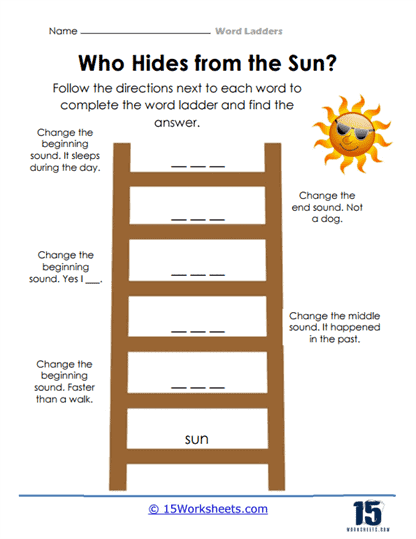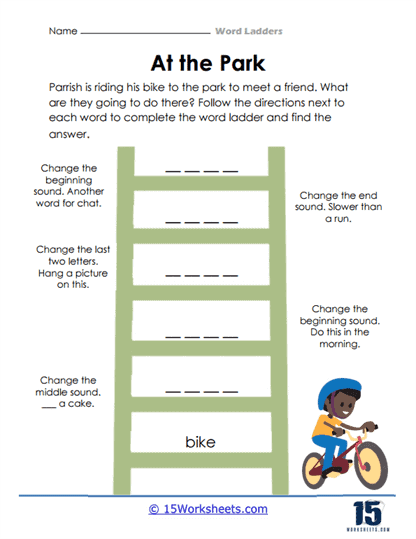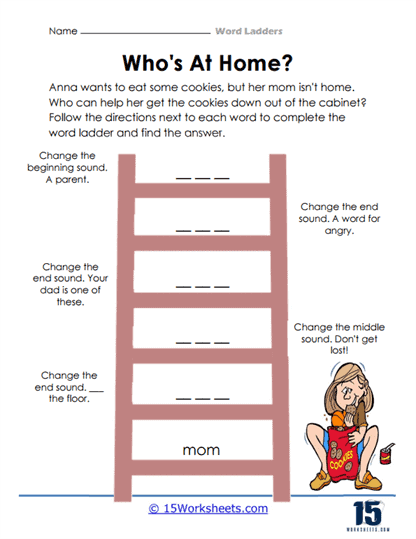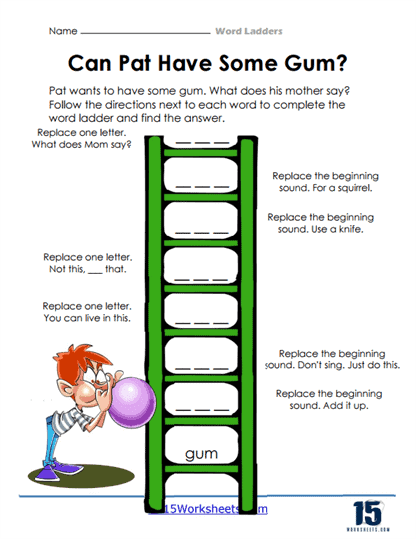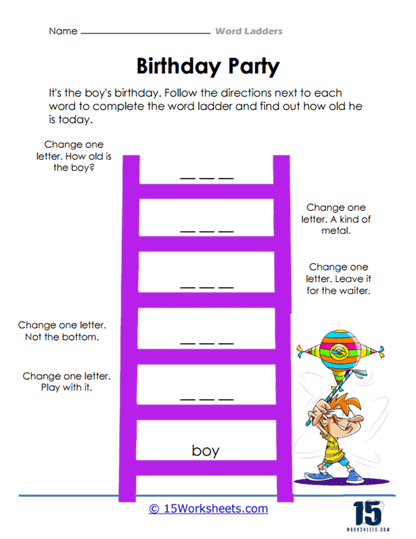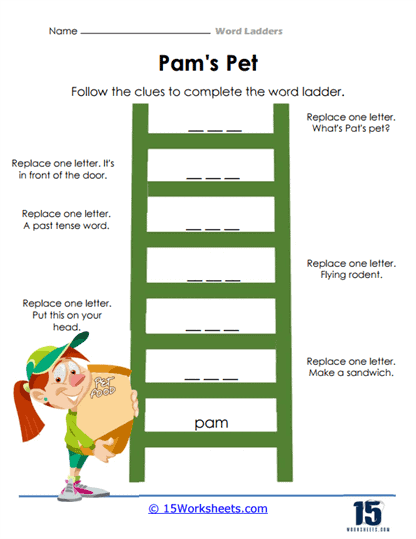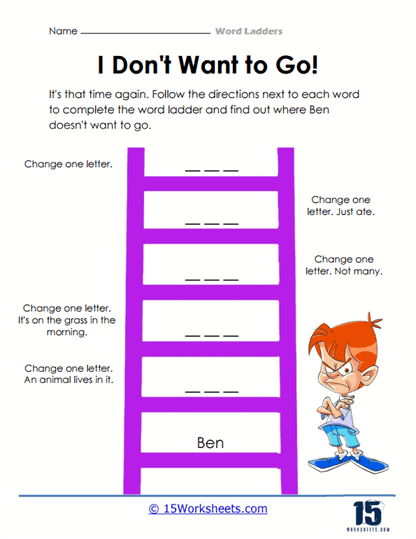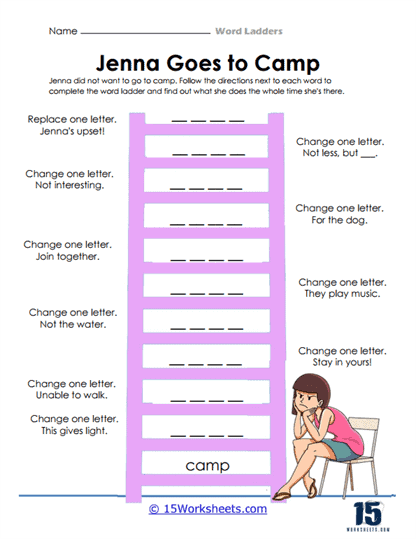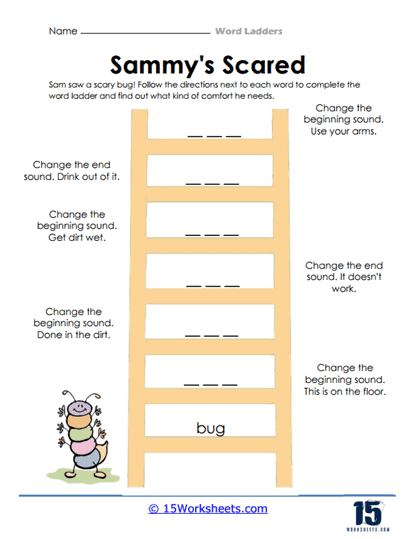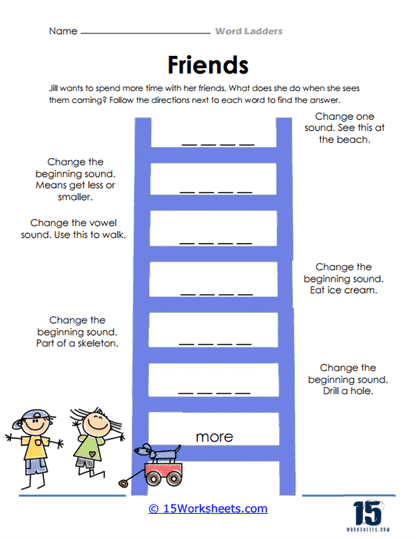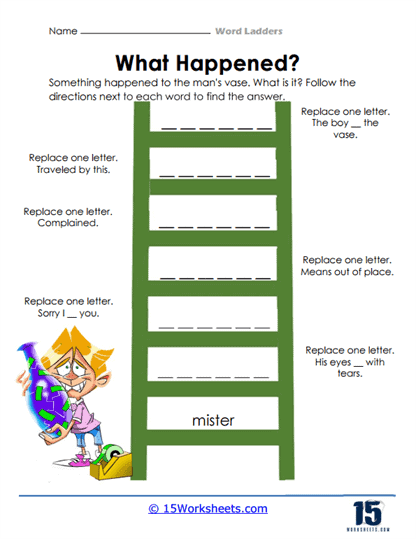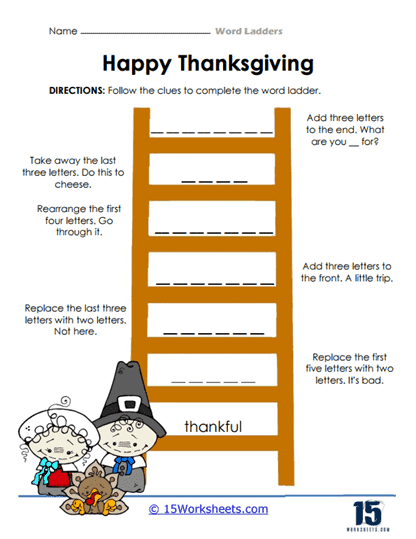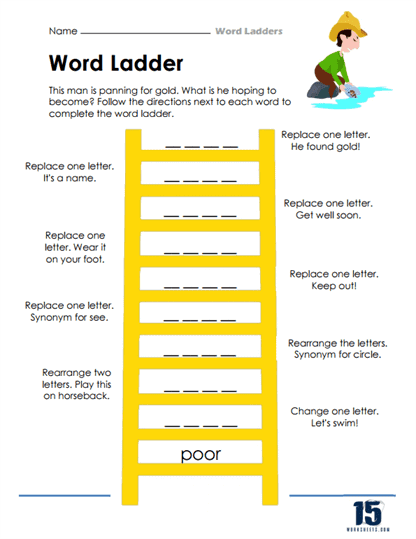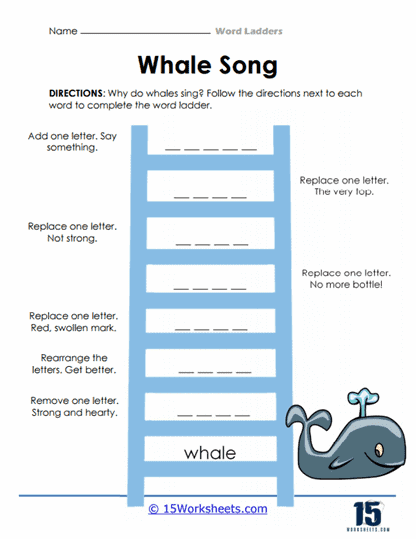Word Ladders Worksheets
All About These 15 Worksheets
This collection of 15 worksheets is more than just a set of vocabulary exercises; it is an invitation to dive into the playful and intellectually stimulating world of word games, drawing inspiration from none other than the legendary British author, Lewis Carroll. First introduced by Carroll in 1877, the Word Ladder puzzle has stood the test of time, captivating the minds of students and language enthusiasts for generations. This particular series takes that classic concept and turns it into an engaging learning tool, offering a fresh and dynamic approach to vocabulary building.
Each worksheet in this collection features its own unique Word Ladder puzzle, designed to challenge students by requiring them to transform one word into another. This transformation occurs through small, incremental changes-altering just one letter at a time-while keeping all other letters intact. The brilliance of this exercise lies in its simplicity, which belies the deep cognitive engagement it fosters. With each letter change, students are not just swapping one letter for another; they are exploring the vast landscape of language, learning to navigate the intricacies of word structure, and sharpening their ability to think critically about language.
The breadth of these worksheets ensures that students from a variety of grade levels and language proficiency backgrounds can participate in this intellectually enriching activity. From early learners just beginning to grasp basic word patterns to more advanced students honing their linguistic dexterity, these Word Ladders offer a rewarding challenge. Each puzzle presents a distinct theme or concept that guides the transformation process, whether it’s related to animals, weather, or other common categories. This thematic approach not only makes the exercises more engaging, but also helps students form connections between words and ideas, further enhancing their learning experience.
But these worksheets are not merely about solving puzzles-they are about cultivating a deeper understanding of language itself. As students work through each ladder, they are called upon to employ a variety of critical thinking skills. They must analyze word patterns, identify which letter changes make logical sense, and navigate through each step with precision. This process requires careful decision-making and fosters an intuitive sense of how words function in relation to one another. In doing so, students build essential language skills that go far beyond vocabulary. They become adept at recognizing word structures, predicting possible word transitions, and expanding their understanding of the relationships between letters and sounds.
Beyond the mechanics of wordplay, these worksheets serve as a gateway to vocabulary expansion. Each puzzle introduces students to new words, some familiar, others more obscure, that stretch their language knowledge and push them to incorporate fresh terms into their lexicon. This exposure to a broader range of vocabulary not only improves their word recognition but also enhances their ability to communicate more effectively. Every new word learned is a tool added to their linguistic toolkit, empowering them to express their thoughts and ideas with greater clarity and precision.
Word Ladders encourage students to experiment with language, to test different possibilities, and to approach problem-solving in a flexible, imaginative way. Unlike traditional rote learning methods, which can feel rigid and repetitive, these puzzles invite exploration and experimentation. Each step of the Word Ladder can spark curiosity, leading students to ponder the connections between words in ways they may not have considered before. This blend of logic and creativity makes the learning process both rigorous and enjoyable, keeping students engaged and motivated as they work through each challenge.
For educators, this series of worksheets is an invaluable resource. It offers a captivating way to engage students in language learning while fostering a love for word games that can last a lifetime. Teachers can integrate these worksheets into a variety of lesson plans, using them as a fun warm-up activity, a meaningful homework assignment, or even as part of a larger vocabulary-building unit. The versatility of these puzzles makes them suitable for both individual practice and collaborative group work, encouraging students to work together to find solutions, discuss strategies, and learn from each other’s insights.
What are Word Ladders?
Word Ladders, sometimes known as Doublets or Word Golf, is more than just a game-it’s a journey through the structure and beauty of language. This unique puzzle was invented by none other than Lewis Carroll, the celebrated British author known for Alice’s Adventures in Wonderland. In 1877, Carroll introduced this simple yet intellectually stimulating word game, which has captivated players for over a century. But beyond its historical origins, Word Ladders remain a compelling tool to sharpen minds, enrich vocabularies, and entertain in a way that few word games can.
How It Works
At its core, a Word Ladder is a mental exercise in transformation. The challenge begins with a single word, and the player’s goal is to transform that word into a target word by changing one letter at a time. Here’s the catch-each intermediate step must also be a valid word in the same language. In this way, a simple string of letters is not just altered; it morphs into new, meaningful words that stand on their own.
Consider this as a journey, where each step must be carefully chosen. The transformation is not random but calculated, demanding both linguistic knowledge and strategic thinking. The player must sift through possibilities, weighing potential paths forward while keeping track of how each change affects the ultimate destination.
For example, let’s examine how we might transform the word “cold” into the word “warm.” The solution looks something like this:
cold
cord
word
ward
warm
At first glance, the puzzle might seem straightforward, yet each change reveals the intricate web that words weave in our language. Notice how a single letter shifts, creating new words at every turn, all while subtly moving closer to the final target. What began as a word describing a low temperature ends up as its opposite, “warm,” and every step of the journey is a valid word that can stand on its own.
The Strategy Behind Word Ladders
While playing Word Ladders may appear to be a game of trial and error, success often comes down to strategy. Players must consider more than just the letters themselves-they need to think about the structure and flow of language. Which letters are most likely to lead to another valid word? Which changes bring the player closer to the target word, rather than leading them down an unnecessary detour?
This process helps develop essential problem-solving skills. In many ways, Word Ladders function like puzzles within puzzles. Each decision is a small but significant challenge, and the cumulative effect of these choices creates a satisfying sense of accomplishment once the final word is reached. The game encourages players to think logically and creatively at the same time, balancing intuition with linguistic rules.
How Do These Activities Help Students?
Word Ladders are more than just a fun word game-they are a powerful educational tool that can transform how students approach language learning. Whether used in classrooms, tutoring sessions, or at home, these puzzles engage students in a way that feels less like traditional study and more like play. However, beneath the surface of this game lies a wealth of educational benefits that extend beyond simple wordplay. By incorporating Word Ladders into their learning, students can improve vocabulary, spelling, critical thinking, and more, all while enjoying the process.
Let’s dive deeper into the ways Word Ladders help students grow, develop key skills, and build their confidence, making language learning both effective and engaging.
Building a Stronger Vocabulary
One of the primary benefits of Word Ladders is their ability to expand a student’s vocabulary. As students work through each puzzle, they encounter a variety of words, some of which may be unfamiliar. This repeated exposure to new words, in context, enhances their word knowledge in a natural and engaging way. Unlike rote memorization techniques, Word Ladders allow students to learn new words through problem-solving, which makes the words more likely to stick in their long-term memory.
For instance, if a student is tasked with transforming the word “cold” to “warm,” they might encounter intermediate words like “cord” or “ward”-words they may not use regularly. As they progress through the ladder, students begin to internalize these words, their meanings, and how they fit into the larger structure of the language. Over time, this process builds a more diverse and robust vocabulary, giving students the tools to express themselves more effectively both in speech and writing.
Reinforcing Spelling Skills
Spelling is another area where Word Ladders shine. Since each step of the ladder requires the creation of a valid word, students must pay close attention to how words are spelled. Unlike multiple-choice spelling exercises, which can sometimes be too passive, Word Ladders engage students actively in the process of spelling. They must think critically about the letters in each word and how altering just one letter can change both the word’s meaning and its structure.
In this way, Word Ladders reinforce correct spelling through constant practice. Every time a student creates a new word in the sequence, they are actively practicing spelling without even realizing it. This repetition helps solidify correct spelling patterns in their minds, making them more confident and accurate spellers over time.
Because the game involves changing just one letter at a time, students are more likely to focus on letter patterns and common spelling rules. For instance, they might recognize that many words end in “-ing” or notice how consonants and vowels often interact in predictable ways. These observations, made in the context of a game, are more engaging and memorable than traditional spelling drills.
Developing Problem-Solving Skills
One of the most valuable aspects of Word Ladders is the way they encourage problem-solving and critical thinking. The game isn’t just about finding random words-it’s about strategically thinking through the process of transforming one word into another. Students must analyze the starting and ending words, consider possible letter changes, and work their way through potential solutions.
This requires both creativity and logic. Students must think critically about each step and evaluate which letter changes will lead them closer to their goal. In doing so, they develop their ability to analyze patterns and come up with solutions to problems-a skill that extends far beyond the classroom.
This kind of strategic thinking has applications in almost every area of learning. Whether it’s solving a math problem, writing an essay, or analyzing scientific data, the ability to break down a challenge into smaller, manageable steps is essential. Word Ladders offer students a fun way to hone this skill in a low-stakes, enjoyable environment.

